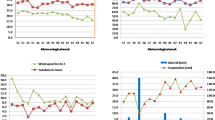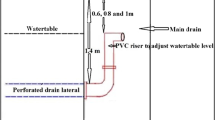Abstract
The uncertainty of monsoon rainfall and the decreasing availability of irrigation water, as a result of climate change, and high water demand of other sectors have resulted to wide adoption of alternate wetting and drying (AWD) technique especially in irrigated lowland rice production to overcome water scarcity. However, under climate change circumstances, AWD can be optimized when taking advantage of favorable water seasonality conditions to increase crop yield and irrigation water use efficiency. Therefore, a field trial was conducted to find suitable water depth for reducing rice irrigation water use by combining four different water depth treatments (T2cm, T3cm, T4cm, and T5cm) with rainfall through a randomized complete block design having 3 replications. Water depths were applied weekly from transplanting to heading. The results showed that water stress at vegetative stage decreased plant height and tillers number between 7 and 33 % at panicle initiation, followed by total and partial growth recovery. In addition, panicle number per hill showed a 53–180 % decrease at the heading stage. Severe water stress induced by the lowest water treatment significantly reduced yield components between 15 and 52 % at harvest. It was found that weekly application of 3 cm water depth combined with rainfall improved AWD effectiveness, and yielded the highest beneficial water productivity with less yield expenses.







Similar content being viewed by others
References
Allen RG, Pereira LS, Raes D, Smith M (1998) Irrigation and drainage paper No 56. FAO, Rome
Ascha F, Dingkuhn M, Sow A, Audebert A (2005) Drought-induced changes in rooting patterns and assimilate partitioning between root and shoot in upland rice. Field Crop Res 93(2–3):223–236
Barker R, Dawe D, Tuong TP, Bhuiyan SI, Guerra LC (1998) The outlook of water resources in the year 2020: challenges for research on water management in rice production. In: Proceeding of the 19th session of the international rice commission, assessment and orientation towards the 21st century, Cairo, pp 96–109
Belder P, Bouman BAM, Chabagon R, Guoan L, Quiland EJP, Yuanhua L, Spiertz JHJ, Tuong TP (2004) Effect of water-saving irrigation on rice yield and water use in typical lowland conditions in Asia. Agric Water Manag 65(3):193–210
Bouman BAM, Tuong TP (2001) Field water management to save water and increase its productivity in irrigated lowland rice. Agric Water Manag 49(1):11–30
Bouman BAM, Lampayan RM, Tuong TP (2007) Water management in irrigated rice: coping with water scarcity. IRRI, Los Banos
Cabangon RJ, Castillo EG, Tuong TP (2011) Chlorophyll meter-based nitrogen management of rice grown under alternate wetting and drying irrigation. Field Crop Res 121(1):136–146
Davatgar N, Neishabouri MR, Sepaskhah AR, Soltani A (2009) Physiological and morphological responses of rice (Oryza sativa L.) to varying water stress management strategies. Int J Plant Prod 3(4):19–32
Fageria NK (2007) Yield physiology of rice. J Plant Nutr 30(6):843–879
FAO (2007) Coping with water scarcity: challenge of the twenty-first century.UN-Water, Food and Agriculture Organization, Rome, Italy
Geerts S, Raes D (2009) Deficit irrigation as on-farm strategy to maximize crop water productivity in dry areas. Agric Water Manag 96:1275–1284
Lilley JM, Fukai S (1994) Effect of timing and severity of water deficit on four diverse rice cultivars III. Phenological development, crop growth and grain yield. Field Crop Res 37(3):225–234
Meiri A, Naftaliev B, Shmuel D, Yechezkel H, Communar G, Friedman SP (2011) Short-term watering-distance and symmetry effects on root and shoot growth of bell pepper plantlets. Agric Water Manag 98(10):1557–1568
Moya P, Hong L, Dave D, Chen C (2004) The impact of on-farm water irrigation techniques on rice productivity and profitability in Zhanghe irrigation system, Hubei, China. Paddy Water Environ 2(4):207–215
Ndiiri JA, Mati BM, Home PG, Odongo B, Uphoff N (2012) Comparison of water savings of paddy rice under system of rice intensification (SRI) growing rice in Mwea, Kenya. Int J Cur Res Rev 4(6):63–73
Pirdashti H, Sarvestani ZT, Bahmanyar MA (2009) Comparison of physiological responses among four contrast rice cultivars under drought stress conditions. World Acad Sci Eng Technol 25:52–53
Sarvestani ZT, Pirdashti H, Sanavy SA, Balouchi H (2008) Study of water stress effects in different growth stages on yield and yield components of different rice (Oryza sativa L.) cultivars. Pak J Biol Sci 11(10):1303–1309
Tan X, Shao D, Liu H, Yang F, Xiao C, Yang H (2013) Effects of alternate wetting and drying irrigation on percolation and nitrogen leaching in paddy fields. Paddy Water Environ 11(1–4):381–395
Thakur AK, Rath S, Patil DU, Kumar A (2011) Effects on rice plant morphology and physiology of water and associated management practices of the system of rice intensification and their implications for crop performance. Paddy Water Environ 9(1):13–24
Traore S, Wang YM, Kan CE, Kerh T, Leu JM (2010a) A mixture neural methodology for computing rice consumptive water requirements in Fada N’Gourma Region Eastern Burkina Faso. Paddy Water Environ 8(2):165–173
Traore S, Wang YM, Kerh T (2010b) Artificial neural network for modeling reference evapotranspiration complex process in Sudano-Sahelian zone. Agric Water Manag 97(5):707–714
Tuong TP, Bastiaansseen SI (1999) Increasing water-use efficiency in rice production: farm-level perspectives. Agric Water Manag 40(1):117–122
Tuong TP, Bouman BAM, Mortimer M (2005) More rice, less water-integrated approaches for increasing water productivity in irrigated rice bed-based systems in Asia. Plant Prod Sci 8(3):231–241
Wang YM, Namaona W, Traore S, Zhang ZC (2009a) Seasonal temperature-based models for evapotranspiration estimation under semi-arid conditions of Malawi. Afr J Agric Res 4(9):878–886
Wang YM, Traore S, Kerh T (2009b) Applying evapotranspiration reference model and rainfall contribution index for agricultural water management plan in Burkina Faso. Afr J Agric Res 4(12):1493–1504
Wang YM, Traore S, Namaona W, Kerh T (2009c) Agricultural productivity potential assessment by using rainfall contribution index in Sub-Sahara Africa. WSEAS Trans Inf Sci Appl 6(5):839–848
Xu Z, Zhou G, Shimizu H (2010) Plant responses to drought and rewatering. Plant Signal Behav 5(6):649–654
Ye Y, Liang X, Chen Y, Liu J, Gu J, Guo R, Li L (2013) Alternate wetting and drying irrigation and controlled-release nitrogen fertilizer in late-season rice. Effects on dry matter accumulation, yield, water and nitrogen use. Field Crop Res 144:212–224
Zhang Y, Tang Q, Peng S, Xing D, Qin J, Laza RC, Punzalan BR (2012) Water efficiency and physiological response of rice cultivars under wetting and drying conditions. Sci World J. doi:10.1100/2012/287907
Acknowledgments
The authors would like to thank Taiwan’s International Cooperation and Development Fund (ICDF) for their supports during the implementation of this study. Acknowledgments also go to Taiwan National Science Council (NSC) for funding this research under the grant 102-2221-E-020-028; without their supports this study would not be possible.
Author information
Authors and Affiliations
Corresponding author
Rights and permissions
About this article
Cite this article
Kima, A.S., Chung, W.G., Wang, YM. et al. Evaluating water depths for high water productivity in irrigated lowland rice field by employing alternate wetting and drying technique under tropical climate conditions, Southern Taiwan. Paddy Water Environ 13, 379–389 (2015). https://doi.org/10.1007/s10333-014-0458-7
Received:
Revised:
Accepted:
Published:
Issue Date:
DOI: https://doi.org/10.1007/s10333-014-0458-7




